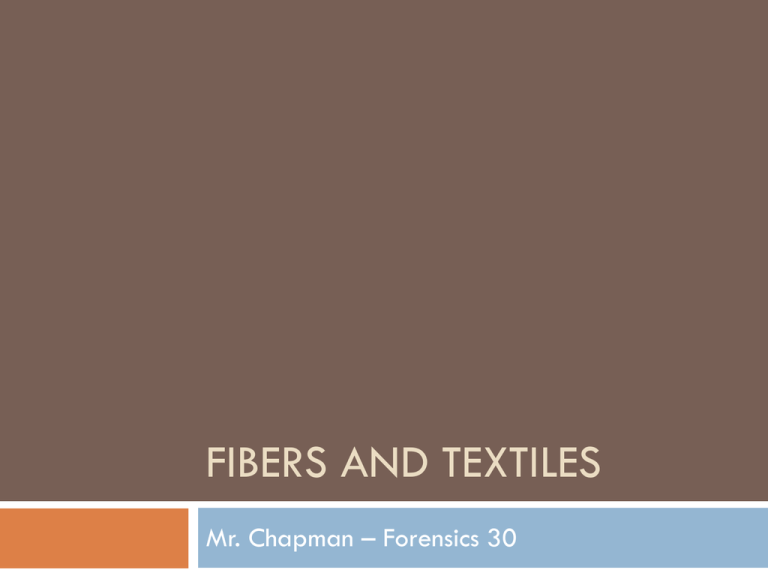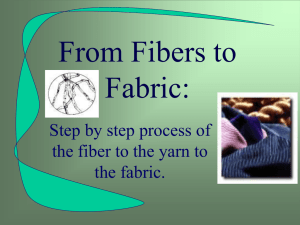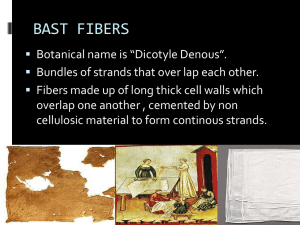Fibers and Textiles Intro
advertisement

FIBERS AND TEXTILES Mr. Chapman – Forensics 30 What is a fiber? Fibers are used in forensic science to create a link between a crime and a suspect. Unlike fingerprints and DNA evidence, fibers are not specific to a single person. For example, a thief may own a jacket that matches the type of fiber found at a crime scene. However, that does not mean the thief was present at the crime scene, as the jacket could belong to anyone. Humans Shed? When humans wear clothes, those clothes shed fibers. When you walk on a carpet, sit on a couch, or pull on a sweater, fibers can fall off or get picked up. Forensic scientists look for these small fibers in order to determine where it is likely that a suspect has been, although they never provide actual proof. Why is this? Criminals Try to be Sneaky Many criminals are aware of some methods that investigators try to use to identify them, such as fingerprints and hair samples. As a result, these criminals often wear gloves and hairnets. However, many fibers are extremely small and often go unnoticed, and can provide clear connections between suspects and locations. Fibers are Trace Evidence Fibers are a form of trace evidence. Recall that trace evidence is any evidence that is left behind from the contact of a person to an object or place. Fibers originate from all sorts of objects, such as carpets, clothing, linens, furniture, insulation, or rope. Similar to hair, they may be transferred either by direct transfer or also secondary transfer. Direct vs. Secondary Transfer It is important in this study to remember the difference between direct and secondary transfer. Direct transfer occurs when fibers are transferred directly from the suspect to the victim or vice versa. Secondary transfer occurs when a victim picks up a fiber from somewhere else and transfers it to the suspect, or vice versa. Early Collection of Fibers is Critical Within 24 hours, an estimated 95% of all fibers may have fallen from a victim or been lost from a crime scene. Thorough examination of the victim and the crime scene is required in order to get a fiber evidence. Only fibers you would not expect to find on a victim are investigated by CSIs. Selection of Hair Samples CSIs will not examine fiber evidence that they would expect to find on a victim. For example, if a victim lived in a house that had blue carpets and rugs everywhere, a CSI would not examine a blue fiber they found on a victim. Sketchy thought: If you are a killer, should you wear colours that match your victims’ house? How Forensic Scientists Use Fibers Evidence of any kind must be evaluated, and this is especially important for fibers, because they are plentiful in the environment. Unique Fibers are Most Useful Why do you think that a unique fiber is more useful than a common one? For example, white cotton is a much less valuable fiber to find on a victim than an angora fiber. Questions Scientists Ask Themselves About Fibers Questions to Ask About Fiber... 1. 2. Type of fiber – what is the composition of the fiber? How common or rare is it? What suspects or victims or part of the crime scene had this type of fiber on them? Fiber color – Do the fibers from the suspect’s clothes match the color found in the victim’s house? Is the dye the same? Questions to Ask About Fiber... 3. 4. 5. Number of fibers found – How many fibers were found – one or hundreds? Where the fiber was found – How close can you place the suspect to the scene of the crime – in the house, or close to a victim’s body? Textile the fiber originated from – Are these carpet fibers, or upholstery from a car? Questions to Ask About Fiber... 6. 7. 8. Multiple Fiber Transfers – Is there only one type of fiber transferred at the crime scene? Or are there fibers from numerous sources from carpets and clothes and bedding? Type of crime committed- Ws the crime violent, a break-and-enter, a kidnapping? Time between crime and discovery of fiber – How long ago did the transfer take place – an hour, a day, or a week? Sampling and Testing Fibers How fiber evidence is gathered and tested. How Fiber Evidence is Collected Fiber evidence is collected with three main tools: Special Vacuums, Sticky Tape, and Forceps Clearly, it is important to be very accurate in recording where the fibers were found. Inaccurate documentation may render the evidence useless in court. What the Forensic Scientist Does Often, the forensic scientist will obtain small amount of fibers from a crime scene, perhaps even just a single fiber. The first thing the scientist must do is identify the type of fiber and its characteristics (such as colour and shape). After that, the scientist must attempt to match it to fibers from a suspect source, such as a car or home. Fibers Can be Precious Sometimes the forensic scientist only has one fiber to work with. When this is the case, the scientist cannot do any tests that would result in the destruction of the fiber, since you would ruin your evidence There are 2 methods of fiber analysis that do not damage them in any way. Polarizing Light Microscopy Allows the scientist to look at the fiber using specific wavelengths of light. The appearance of the fiber under this type of microscope can tell the type of fiber. Natural fibers, like wool or cotton, only require an ordinary microscope to see the distinguishing characteristics. Infrared Spectroscopy Emits a beam that bounces off the material and returns to the instrument. How the beam of light has changed reveals something of the chemical structure of the fiber, making it easy to tell the difference between fibers that simply look alike. Destructive Tests If many fibers are available, scientists can perform tests on them that will ultimately destroy them. Such tests include burning tests (also called flame tests) and tests that involve dissolving the hair in various substances.






